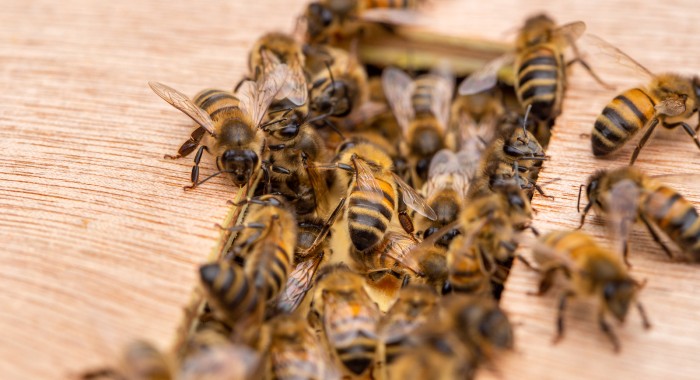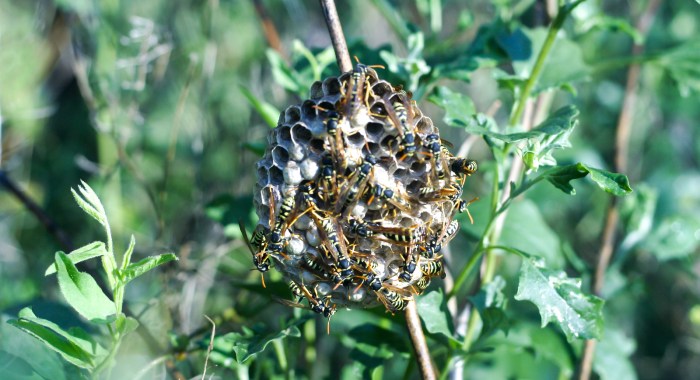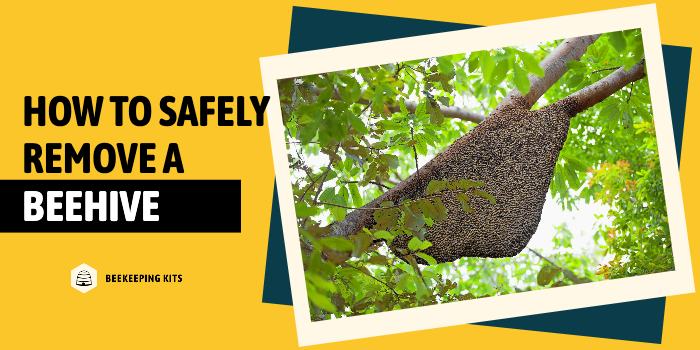Knowing how to safely remove a beehive is an essential first step before going anywhere near a problematic hive.
If you’re currently dealing with the removal of a swarm and/or a hive, then safety and efficiency are paramount.
Here, we’ll talk briefly about the safe removal as well as a few other points that may come in handy.
Firstly, Let’s Get To Know The Bees
Before you get to know the ins and outs of dealing with removals, it’s good to quickly get to grips with the bees themselves. You’ll likely run into bumblebees, wasps, Asian hornets, or European hornets.
Bumblebees are large, round, and furry. They are a lot more imperious than typical honeybees that you may see and they are huge pollinators.
It’s best to stay away from their nests and hives if you aren’t aware of how to behave around them and let them die out at the end of summer. They rarely sting so it’s good not to disturb them.
Wasps are also important pollinators, but they can often be more aggressive. Their buzz is a lot more high-pitched and they’re much leaner.
Beekeepers typically do not assist in the removal of wasps and it’s good to stay away as they’re more unpredictable.
European hornets and Asian hornets will have a very loud buzz, so you’ll know what you’re dealing with.
They’re typically found in wooden areas and are pretty intimidating, so it’s wise to steer clear.
Beekeepers will be able to help you out in terms of identifying the kinds of hornets and the steps that should be taken moving forward.
Why Are Hives Created And What Are Their Purpose?
Hives are simply created by bees (or by man) to house bees. We create them to artificially simulate habitats for them, but their natural inclination is to use straw, wood, pottery, and anything else remotely similar that they can get their hands on.
They create hundreds of honeycomb-shaped cells and form a large nest for each bee to house itself in. They’ll use propolis to fill crevices and cracks.
Their hives look the way they do because bees have evolved to understand their surroundings.
The hexagonal pattern they create allows them to fit perfectly though and to comfortably rest inside. Bees actually measure the depth of each cell with their bodies. They are a smart species of being.
Are Bees Really To Be Feared As Much As They Are?

At the end of the day, humans will always have fears and phobias of bees. They carry around a certain reputation and intimidating behavior, so we will tend to be cautious around them regardless of how aggressive they are.
They should be respected but not feared. They are non-aggressive by nature.
You only have to look at the way bee handlers and beekeepers behave and the casual nature of them in their day-to-day jobs.
There is a whole host of reasons not to be afraid of bees when you ever encounter an unexpected hive. A lot of it is fuelled by a lack of knowledge.
Once you know more, you’ll become a lot calmer around them. In the grand scheme, all they wish for is to enhance their relationship with flowers.
They want to pollinate and create honey, that’s their purpose in life. They help us and we help them.
It’s a little more accepted that you might be afraid of wasps as they are carnivores out of the two.
Bees are vegetarians and will only be interested in dealing with pollen and nectar. If you truly attack them and allow them to feel threatened, they’ll sting as a last resort in order to protect themselves and those around them.
Why Do They Swarm?
Swarming is typically caused by the nectar flow in the spring. Bees only really want to do their jobs – which is to deal with all kinds of plants that will be in your vicinity.
When the plants are in bloom, they have an array of nectar and pollen resources.
They’ll begin to gather around March time and the secondary swarm will usually occur a little later in the season.
The first few swarms are more likely to be successful as they will have had time to set up and gather resources in order to survive certain things such as the coming winter.
They’ll stay for as long as they can – it all depends on the weather conditions and the situation they find themselves in.
Early Signs That A Beehive May Be Forming Or Present

Obviously, if you see a few bees making their way towards you, then the chances are that there will be a few more scattered around the area.
This could possibly be an indicator that there is a hive either present or in the making. There are a few things to do that are simply common sense, but many will not think to do these tasks.
Listen out for noises coming from walls, chimneys, garages, sheds, and anything that you feel may be vacant and not kept up by people.
Simply taking a little notice of your surroundings can help save you from dealing with further issues.
What Are The Correct Steps In Removing A Beehive?
Firstly, you’re going to want to make sure that you’ve fully established the exact location and the severity of the problem you have at hand.
You may think you know where the hive is, but it’s wise to figure out exactly before you make any rash calls. They can find themselves in the most awkward and foul of locations at times.
In terms of dealing with the hive yourself, you’re going to want to make sure you work when the hive is not at its peak.
Late in the winter or early spring when the population is the smallest – that’s when you’re going to want to make your move.
BUT… do NOT attempt to remove a beehive without the proper equipment. Doing so won’t just put yourself at risk, you’ll also put people around you and even the bees themselves in danger.
It is for this reason most people opt for the safest solution, calling in a local beekeeper to remove the hive safely and effectively.
The DIY Approach
If you do decide to attempt it yourself, you’ll need protective clothing that includes a veil and leather gloves as a minimum.
However you choose to remove a beehive, there is always the possibility the bees will become aggressive and sting any unprotected areas.
We do NOT recommend killing the bees using pesticides or any other method.
Remember, bees are an endangered species and essential pollinators. We should all be doing everything we can to help them thrive. That said, bees are not a protected species, which means you can kill them if you need to, but it should only be done as a last resort.
That leaves us with three natural bee removal options:
Smoke

Perhaps one of the safest, most effective natural ways to remove a beehive is to smoke it out. Beekeepers often use smoke to help keep bees calm, however, for removing a hive, you’ll have to get more serious.
Light a wood fire as close to the hive as you safely can (not so close that the beehive or anything else catches fire). Add grass or cardboard to create extra smoke.
The bees will vacate the hive as they will assume there is a forest fire in progress. Once they have departed, they rarely come back giving you chance to remove the hive by hand.
Scents
Similar to the smoke method, but perhaps more neighbour-friendly for built-up areas, there are a number of scents that are said to cause bees to leave their hive. These include garlic, citronella, and peppermint.
Use scented candles, sprays or even (in the case of peppermint) actual plants near the hive to encourage the bees to move on.
Keep in mind this is a low impact, slow process. You’ll need to persevere to completely remove the bees.
Relocation
Perhaps the fastest, most effective, and least stressful option for the bees is to physically remove and relocate the hive.
However, particularly in the case of honey bees, this requires expertise and should only ever be attempted by experienced beekeepers.
The good news is, many local swarm collectors will be happy to conduct this service for a reasonable cost (some may even be willing to do it for free).
Whichever route you choose, once the hive has been removed, you’re going to want to clean up that area with soap and water.
They will have left quite the mess, so make sure you get rid of every little bit they left behind.
Plug all entrances where they will be able to regain any kind of entry point if they managed to build their hive in an obscure place.
Safety Measures For Yourself
We talked about this during the process, but you’re going to want to make sure that you’re covered from head to toe in protective gear. Ensure they’re long and thick.
Tuck everything in so that no cavities are left – bees will find their way in if they can.
Think about putting on some safety goggles, a mask, and something like a scarf to protect any exposed areas.
How To Tell If You Are Allergic To Bees
If you are allergic to bees, you could be fatally wounded in the worst case. If you are even the slightest bit allergic, then it’s wise to call a professional.
Some symptoms include the likes of swelling, palpitations, vomiting, light-headedness, and fainting. Don’t take chances if you feel as though harm may be caused.
Getting In Touch With A Professional Beekeeper
This will be your best bet going forward. Whether you’re slightly experienced or completely in the dark about this kind of work, you’re going to benefit from someone with years of training and knowledge.
The health of both yourselves and the bees will be kept in order if you let a beekeeper work with the hive.
Everybody wins in this instance. Don’t hesitate to get in touch with one if you feel as though things are beyond your control.

